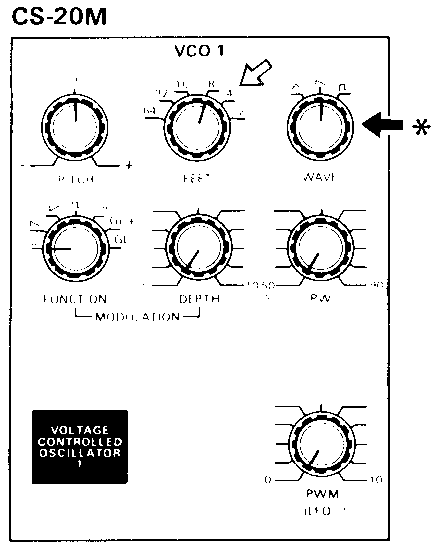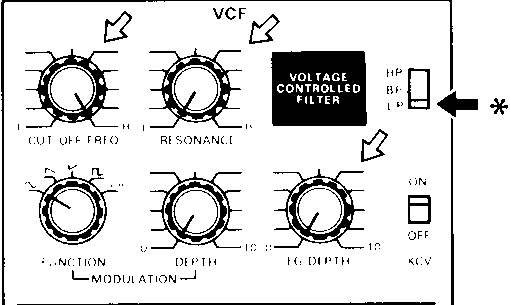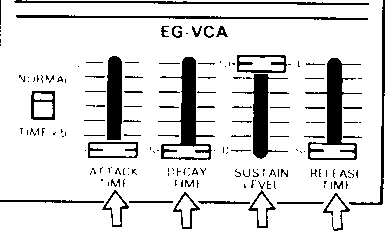My CS20m is wiped of preset patches. If you own a CS20m and could provide settings for the typical lead synth sound I'm willing to pay you via Paypal. adsummers@Comcast.net
While I'm all for free enterprise (you are, of course, free to pay someone to provide you with settings) but we'd be happy to help you learn to master programming your classic Yamaha CS20m analog synthesizer (at absolutely no charge!). As mentioned in your other post, the CS20m was new back in 1979 (actually before I joined the company) but part of the fun of analog synthesizers was the joy of learning to program them.
The Owner's Manual is still available for FREE download from the Official Yamaha Manual Library (and it is a course in basic analog synthesis programming). Before you spend any money, please take a look and if you get stuck you can post your questions here (free)!
Analog synthesizers follow a signal flow where the tone source (oscillator) is fed to the filter (which shapes the timbre) - this is fed to an amplifier (which shapes the loudness). On page 8 of the manual you can see a basic (typical) synth lead sound.
We will be posting an article on the Basics of Synthesis - which should be helpful, whether using one of the current (sample-based) Yamaha Synths (MX, MOX, MOXF, Motif XF, etc) or using an old style analog synth (like your CS20m) - you may also want to (if you are an iPad or iPhone user) download the FREE Yamaha AN2015 virtual analog - (In the App Store under "Yamaha SynthBook") it's an iPhone app that can run in x2 mode on an iPad.
The VCO (Oscillator) has three waveforms to begin with: A Sawtooth, a Pulse and a Triangle Wave.
Sawtooth waves are bright and buzzy - and can be used to build string, brass, synth lead sounds.
Pulse waves are range from hollow to nasal to metallic - and can be used for sounds like clarinets (hollow), oboe (nasal), clavinets (nasal), and wood to metal sounds.
Triangle waves are used for pure tones - flutes.
Sawtooth waves contain all harmonics
Pulse waves contain only odd numbered harmonics
Triangles waves are almost devoid of harmonics
While you can build a Lead Synth sound from any of the source waves... Sawtooth is very "typical" of lead synth sounds... as you will hear:

The Filter (VCF or Voltage Controlled Filter) - takes out upper harmonics (this is a Low Pass filter, LP in the diagram below) it allows low frequencies to pass and blocks high harmonics. This is used to 'shape' the tone or timbre of the sound. There is typically a separate VCF with its own Envelope Generator. And a VCA with its own Envelope Generator
Basic Filter settings for a basic sound:

Here the CUTOFF FREQUENCY is set fully opened - this allows all the upper harmonics to be heard... If you turn this down from max you will notice the sound is less bright and more smooth and rounded in tone.
The Envelope Generator or "EG" is responsible for how the sound comes in (Attack), what it does next (Decay), whether or not it remains sounding while you hold the key (Sustain) and what happens when you lift the key (Release). If the EG is applied to Filter then the timbre changes according to this. If the EG is applied to an Amplifier than overall volume is changed according to the settings.
The relationship between these two Envelope Generators is important to understand. The settings are TIME parameters. The Filter EG changes tone/timbre, the Amplifier EG changes overall loudness. Because "Time" is involved, if there is no amplifier output, you may not get to hear the change tone/timbre. And conversely, if the Filter is closed completely, you may not hear the changes in loudness as applied by amplifier.
The CS20m has two oscillators - these are fed into a device called a MIXER (and it does just what you think it does) it allows you to control the relative volume of the sound sources - typically OSC 1, OSC 2 and a NOISE source (Noise is the other sound component - there are only two types of sound: 1) musical tones and 2) noise. A musical tone is one where the vibrations remain fixed at a specific pitch or frequency... noise is where the vibrations are random... there is only music and noise! The Noise generator can be used to create non-musical sounds.
Envelope = A-D-S-R
If ATTACK is raised - the envelope will cause the sound to take its TIME about coming in. If Attack is at the lowest position - the Attack is immediate.
The DECAY parameter is responsible for whether the sound stays at full volume or drops in level.
If you want the sound to happen while you hold the key - then the SUSTAIN parameter must be raised. When SUSTAIN is higher than the DECAY - the sound will continue as long as you hold the key down.
The RELEASE slider if at its lowest means as soon as you let go of the key the sound stops. If at its highest letting go will cause the sound to slowly disappear.
Basic Envelope for your VCA (Voltage Controlled Amplifier):

If you have two alkaline batteries (I know that the CS20M had its memory locations backed up by regular double A batteries) _ I do not recall any factory presets but its 36 years ago so forgive my memory.
let us know how you make out. And please be on the look out for our in depth look into "Synthesizer Basics" coming soon to Bad Mister's Blog!!!
If you have an i-Pad or i-Phone you can get that Free AN2015 and it can teach you a lot about programming synth sounds!
It is included (Free) with the 40th Anniversary "Yamaha SynthBook" app for iPhone (runs on iPad in x2 mode)
